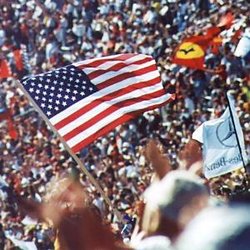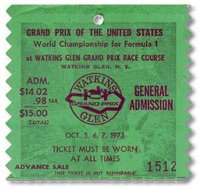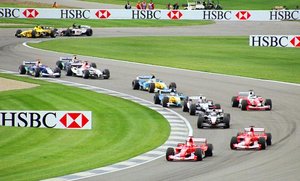United States Grand Prix
|
|
Template:F1 race The United States Grand Prix is a motor racing event which has taken place at various times since 1959 in several locations, at first as a part of the American Grand Prize series and later as a race in the Formula One World Championship.
| Contents |
History
In the early days of Formula One, the Indianapolis 500 was considered an F1 championship event. However, except for Alberto Ascari in 1952, no regular F1 drivers appeared at these races. Not until seven years later would an official Formula One event be held in the States, bringing out the top drivers in the sport.
American Grand Prize
The American Grand Prize series held a United States Grands Prix in 1908 and again from 1910 to 1916.
Sebring
Russian-born Alec Ulmann organized the first F1 American Grand Prix on the road course at Sebring, Florida in December, 1959 as the last race of the season. The starting grid included seven American drivers, but New Zealand's Bruce McLaren, in a Cooper, took his first win in F1 and became the youngest driver ever to win a Grand Prix, up to that time. McLaren took the lead on the last lap of the race when his teammate, Jack Brabham, ran out of fuel. Brabham had to push his car over the line to finish fourth and clinch his and the team's first World Championships. Despite providing an exciting climax to the season, the race wasn't successful from the hosts' standpoint, and the promoters just about broke even.
Riverside
Ulmann moved the race to the Riverside International Raceway in Riverside, California in 1960 where Stirling Moss put on quite a show in his privately-entered Lotus by winning from the pole. Yet, while the driver's purse was enormous (as at Sebring), the event was received no better than the previous year's and became another one-off.
Watkins Glen
In 1961, however, when Cameron Argetsinger was asked to host the race in Watkins Glen, New York, where international road racing was well established, the third time was indeed the charm, as F1 found the United States Grand Prix's home at The Glen. Over the next 20 years, the event became a cherished tradition among the fans as loyal crowds gathered each year on the wooded hills of upstate New York. It was one of the season's most popular events with the teams and drivers as well, receiving the Grand Prix Drivers' Association award for the best organized and best staged GP of the season in 1965, 1970 and 1972. In 1980, financial difficulties and the inability of the circuit to safely handle the increasingly faster and stiffer ground effect cars of the era led to the Glen's exit from the Formula One calendar after Alan Jones won the 1980 race for Williams. Since then, no United States Grand Prix has been held on a natural road course
Long Beach
See United States Grand Prix West.
Las Vegas
See Las Vegas Grand Prix.
Detroit
See United States Grand Prix East.
Dallas, Phoenix
The Vegas course left the schedule after just two seasons, and there were plans for a New York Grand Prix in 1983 to replace it, but this was cancelled unexpectedly in mid-year. Long Beach left the schedule after that year, and the Detroit track was joined in 1984 by a circuit in Dallas' Fair Park. But that event was considered a disaster and after that, the United States had only the Detroit circuit remaining on the Formula One Calendar. 5 years later, F1 left Detroit and again headed west to a Phoenix street course. This lasted 3 years without much success and after the race was axed in 1991, there was no replacement. Mika Häkkinen had a severe accident the year the Formula One last set foot in Phoenix.
Indianapolis
It was not until 2000 that another United States Grand Prix took place, this time at legendary Indianapolis Motor Speedway. The 2.606-mile infield road course uses approximately one mile of the storied oval, but in a clockwise direction. This is distinctly different from most United States motor racing, which is run counterclockwise. However, it follows the general procedure of F1, in which the vast majority of races are run clockwise. The crowd at the 2000 race was estimated at over 225,000, perhaps the largest ever in F1. Michael Schumacher's win was his second of four straight to end the season as he overtook Mika Häkkinen for his third Championship. In 2001, the race went off less than three weeks after 9/11, and many teams and drivers featured special tributes to the US on their cars and helmets. Held in September its first four years, the USGP at Indianapolis was moved to an early summer date in 2004. In 2005 problems with Michelin tyres lead to 7 teams withdrawing from the race after the formation lap. 6 cars raced, and the event was considered a farce. Many commentators questioned whether a United States Grand Prix will be held in Indianapolis again.
Winners of the United States Grands Prix
Events which were not part of the Formula One World Championhip are indicated by a pink background.
See also
External links
- United States Grand Prix History (http://home.cinci.rr.com/usgp/history/)
- Official United States Grand Prix site (http://www.usgpindy.com/)
| Races in the Formula One championship: |
| 2005 championship Grand Prix events: Australian |
Malaysian |
Bahrain |
San Marino |
Spanish |
Monaco |
European |
Canadian |
U.S. |
| Past championship Grand Prix events: Argentine |
Austrian |
Czechoslovakian |
Dutch |
Indy 500 |
Las Vegas |
Luxembourg |
Mexican |
Morocco |



